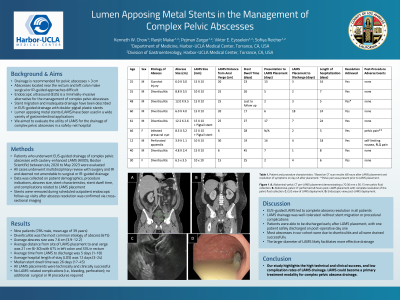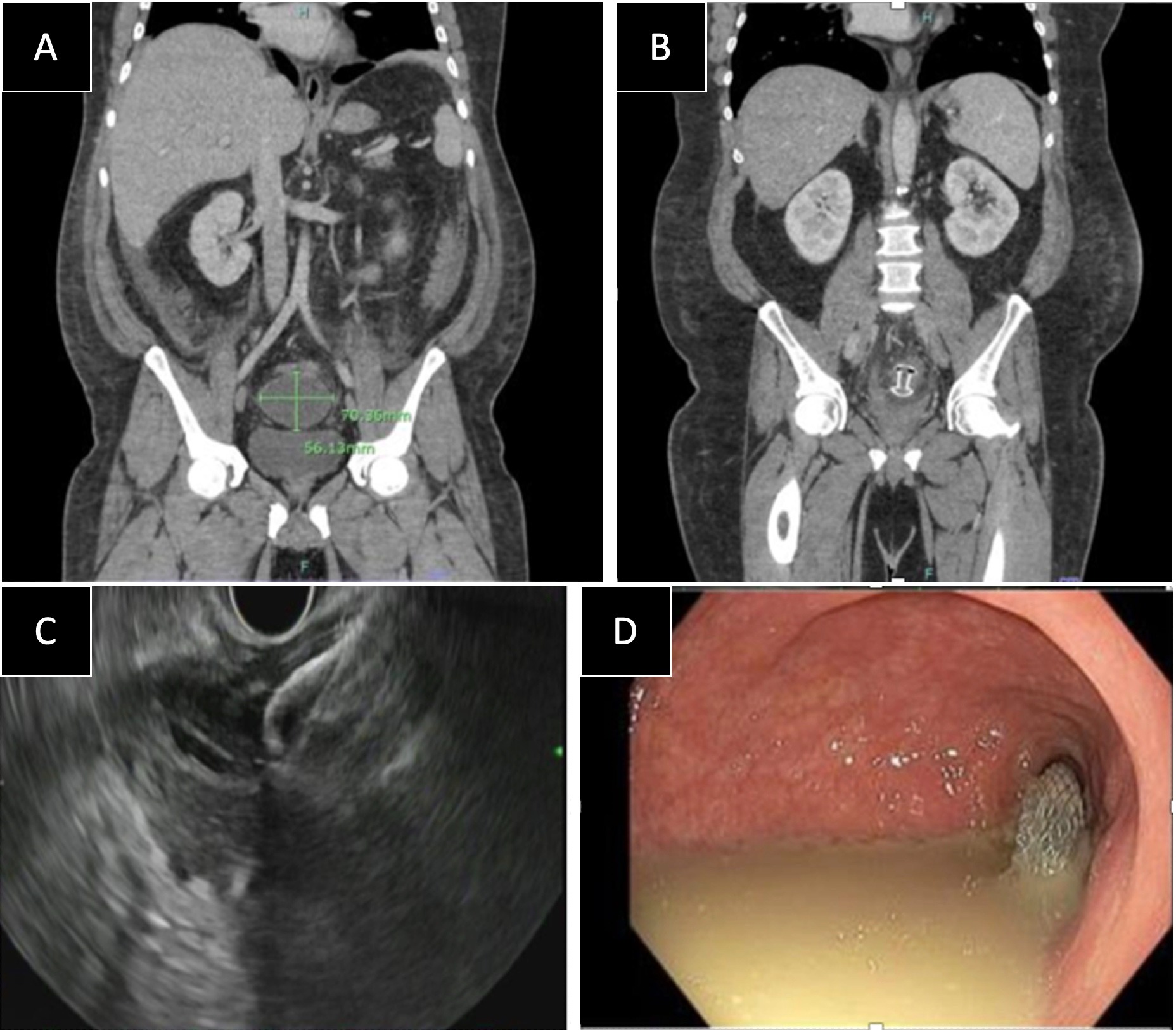Tuesday Poster Session
Category: Interventional Endoscopy
P3712 - Lumen Apposing Metal Stents in the Management of Complex Pelvic Abscesses
Tuesday, October 24, 2023
10:30 AM - 4:00 PM PT
Location: Exhibit Hall

Has Audio

Kenneth Chow, MD
Harbor-UCLA Medical Center
Torrance, CA
Presenting Author(s)
Award: Presidential Poster Award
Kenneth Chow, MD, Ranjit Makar, MD, Pejman Zargar, MD, Viktor Eysselein, MD, Sofiya Reicher, MD
Harbor-UCLA Medical Center, Torrance, CA
Introduction: Lumen apposing metal stents (LAMS) have been utilized in a wide range of therapeutic gastrointestinal applications. We present an initial experience with LAMS for the drainage of complex pelvic abscesses at a large safety-net hospital.
Methods: We analyzed EUS-guided LAMS placements for infected pelvic fluid collections at our institution between July 2020 to May 2023. Data was collected on patient demographics, procedure indications, fluid collection size, stent characteristics, stent dwell time, and complications related to LAMS placement. All cases underwent multidisciplinary review with Surgery and Interventional Radiology (IR) prior to LAMS-assisted drainage; all cases were deemed not amenable to drainage by IR.
Results: Nine patients (78% male, mean age 39 years) underwent EUS-guided drainage of complex pelvic abscesses with cautery-enhanced LAMS during the study period (Table; Figure). Complicated diverticulitis was the most common cause of the abscesses (n=6; 67%). The average time from presentation to drainage was 8 days (2-11 days). Average size was 7.8 cm (3.9 – 12.2 cm). The most common LAMS size used was 15 mm X 10 mm; all stents were placed through the left colon and rectum. All LAMS placements were technically successful. Two patients required plastic double pigtail stent placement through the LAMS to achieve adequate drainage. All patients had complete resolution of the pelvic abscess with a mean stent dwell time of 27 days (19-45 days). One patient with an abscess secondary to diverticulitis declined LAMS removal; cross-sectional imaging 48 hours after LAMS placement showed near-complete resolution of the fluid collection and the patient remained asymptomatic at day 45. One case of a complex pre-sacral cyst that was transformed into an abscess after failed transvaginal fenestration was successfully drained with LAMS; patient remained asymptomatic more than 6 months after LAMS removal. There were no complications such as bleeding or perforation. No patients required additional surgical or IR procedures after LAMS removal.
Discussion: Adequate drainage is the cornerstone of pelvic abscess management; IR or surgical access to the abscess could be challenging, with inadequate drainage and prolonged hospitalization leading to significant morbidity. In our experience, EUS-guided LAMS assisted drainage provides a safe and effective alternative for treatment of pelvic abscesses.

Disclosures:
Kenneth Chow, MD, Ranjit Makar, MD, Pejman Zargar, MD, Viktor Eysselein, MD, Sofiya Reicher, MD. P3712 - Lumen Apposing Metal Stents in the Management of Complex Pelvic Abscesses, ACG 2023 Annual Scientific Meeting Abstracts. Vancouver, BC, Canada: American College of Gastroenterology.
Kenneth Chow, MD, Ranjit Makar, MD, Pejman Zargar, MD, Viktor Eysselein, MD, Sofiya Reicher, MD
Harbor-UCLA Medical Center, Torrance, CA
Introduction: Lumen apposing metal stents (LAMS) have been utilized in a wide range of therapeutic gastrointestinal applications. We present an initial experience with LAMS for the drainage of complex pelvic abscesses at a large safety-net hospital.
Methods: We analyzed EUS-guided LAMS placements for infected pelvic fluid collections at our institution between July 2020 to May 2023. Data was collected on patient demographics, procedure indications, fluid collection size, stent characteristics, stent dwell time, and complications related to LAMS placement. All cases underwent multidisciplinary review with Surgery and Interventional Radiology (IR) prior to LAMS-assisted drainage; all cases were deemed not amenable to drainage by IR.
Results: Nine patients (78% male, mean age 39 years) underwent EUS-guided drainage of complex pelvic abscesses with cautery-enhanced LAMS during the study period (Table; Figure). Complicated diverticulitis was the most common cause of the abscesses (n=6; 67%). The average time from presentation to drainage was 8 days (2-11 days). Average size was 7.8 cm (3.9 – 12.2 cm). The most common LAMS size used was 15 mm X 10 mm; all stents were placed through the left colon and rectum. All LAMS placements were technically successful. Two patients required plastic double pigtail stent placement through the LAMS to achieve adequate drainage. All patients had complete resolution of the pelvic abscess with a mean stent dwell time of 27 days (19-45 days). One patient with an abscess secondary to diverticulitis declined LAMS removal; cross-sectional imaging 48 hours after LAMS placement showed near-complete resolution of the fluid collection and the patient remained asymptomatic at day 45. One case of a complex pre-sacral cyst that was transformed into an abscess after failed transvaginal fenestration was successfully drained with LAMS; patient remained asymptomatic more than 6 months after LAMS removal. There were no complications such as bleeding or perforation. No patients required additional surgical or IR procedures after LAMS removal.
Discussion: Adequate drainage is the cornerstone of pelvic abscess management; IR or surgical access to the abscess could be challenging, with inadequate drainage and prolonged hospitalization leading to significant morbidity. In our experience, EUS-guided LAMS assisted drainage provides a safe and effective alternative for treatment of pelvic abscesses.

Figure: A. Abdominal-pelvic CT pre-LAMS placement demonstrating a 70.36 mm x 56.13 mm pelvic fluid collection. B. Abdominal-pelvic CT performed 48 hours post-LAMS placement with complete resolution of the pelvic fluid collection. C. Endoscopic ultrasound view of LAMS deployment. D. Endoscopic view post-LAMS deployment.
Disclosures:
Kenneth Chow indicated no relevant financial relationships.
Ranjit Makar indicated no relevant financial relationships.
Pejman Zargar indicated no relevant financial relationships.
Viktor Eysselein indicated no relevant financial relationships.
Sofiya Reicher: Boston Scientific – Consultant.
Kenneth Chow, MD, Ranjit Makar, MD, Pejman Zargar, MD, Viktor Eysselein, MD, Sofiya Reicher, MD. P3712 - Lumen Apposing Metal Stents in the Management of Complex Pelvic Abscesses, ACG 2023 Annual Scientific Meeting Abstracts. Vancouver, BC, Canada: American College of Gastroenterology.


